This morning, board your flight to Paro, Bhutan’s only international airport. The flight into Bhutan takes you close to the great Himalaya, offering dazzling scenic views of some of the world’s highest glacial peaks. As you enter the Paro valley, you will pass forested hills with the silvery Pa Chu (Paro River) glistening below, the Paro Dzong (fortress) and Ta Dzong (watch tower) on a hill above the town.
As you exit from the arrival hall of Paro airport, you will be met by your guide and chauffeured to your hotel in Thimphu (1 hour drive). The capital of the Himalayan kingdom of Bhutan, Thimphu is a stronghold of traditional Bhutanese art, architecture and culture. Situated at 2 320 m (7656 ft) above sea level, it is home to over 100,000 inhabitants, including the Royal family of the country. A crucible for urbanisation - this is where you will see modern-day Bhutan infused with more traditional aspects of living. Fun fact, Thimphu is the only national capital city in the world to not have any traffic lights!
En-route stop to visit the Tamchog Lhakhang; built by Thangtong Gyalpo, a pioneering engineer who introduced the construction of suspension bridges into Bhutan and Tibet. It is believed that more than 58 bridges were built across the country however only 2 have survived. One of these bridges still stands strong at the base of the Tamchog Lhakhang. Marvel at the iron bridge reconstructed using original chain links.
Drive onwards to your hotel for check-in and rest over lunch.
Then Embark on a multi-sensory experience as you stroll past the vibrant stalls of the Thimphu Farmer’s Market. Drawing in most of Thimphu’s vivacious residents, the marketplace teems with a range of both local and imported goods and produce. The experience is far more than the items to be bought, but rather about socialising with the colourfully dressed community, full of Bhutanese fare and flare. Many of the stalls sell fresh organically grown vegetables, ready to be transformed into delicious traditional and contemporary Bhutanese dishes, while the other areas promise a plethora of produce imported from India.
Spend three nights at Six Senses, Thimphu. Your accommodation will be in Lodge Suite on Full board (Breakfast, lunch, dinner, and non-alcoholic beverages) basis.
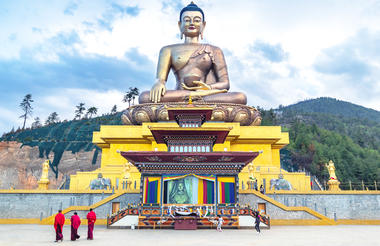
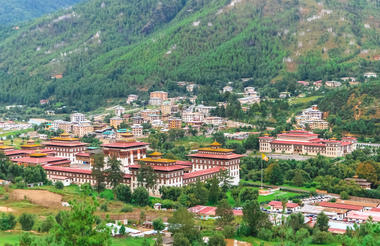
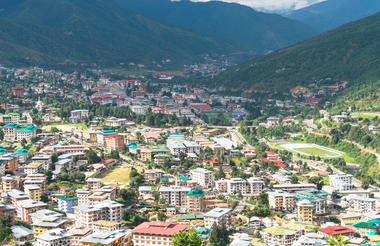
Morning
Tamchog Lhakhang
Early morning attend meditation with Lama. Rise early for a morning meditation session with a lama at our lodge’s intimate Prayer Pavilion. Discover the healing benefits and deep insights that result from a practice of breathwork and setting positive intentions surrounded by the lodge’s serene reflecting ponds with views of Thimphu Valley below.
Post breakfast visit to experience dying.
Next, you will visit the Royal Takin Preserve. Bhutan's national animal is the takin. This large, shaggy and hoofed mammal has a bit of mythology tied to it. Legend has it that the animal was created by the great Buddhist yogi, Drupa Kunley or ‘the Divine Madman’. This species of takin is found only in Bhutan and western Arunachal Pradesh. The Royal Takin Preserve is located just 10 minutes away from Thimphu city. Originally a zoo, the fourth king decided to disband it since keeping animals in cages did not align with Bhutan’s environmental and religious beliefs. The animals were released into the wild, however the takin was too tame to survive, and wandered around the streets of Thimphu. This led to the making of the Royal Takin Preserve. Now the animals are kept in a large enclosure where visitors can observe them.
Return to lodge for lunch.
After lunch visit Pangri Zampa Monestery. Founded in the early 16th century, this complex is a college for traditional astrology. The complex gets its name from the photogenic traditional bridge beside the complex. Every year, this institute releases the official Bhutanese calendar. This institute decides dates for important national events of Bhutan. The dates for past national events such as the coronation day of the fifth Druk Gyalpo, the royal wedding. It is the only college for astrology in the country established as an educational institute to learn and enhance traditional astrology. The college is responsible for deciding dates for important events in Bhutan and it also provides yearly predictions about health, career and more for Bhutanese. More than three hundred monks who are now serving as astrologers in different parts of the country have graduated from this college.
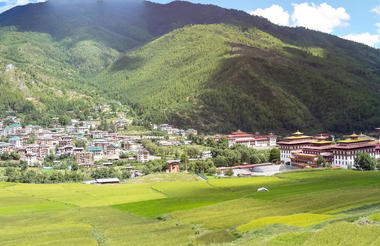
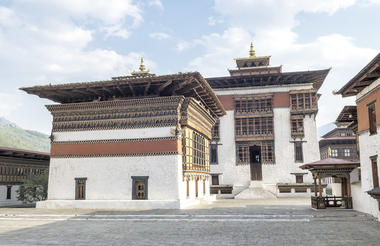
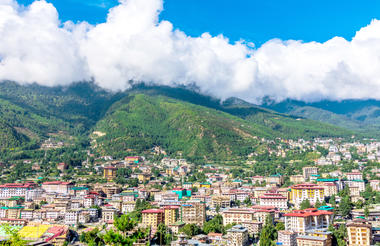
Post breakfast this morning, visit National Memorial Chorten. This well-known landmark in Thimphu was built in 1974 in the memory of the third King, Jigme Dorji Wangchuck; who is popularly regarded as Father of Modern Bhutan. This four-storey structure was built to be seen as the most visible religious landmark in the Dragon Kingdom. It serves as an important place of worship for Thimphu residents, as well as devotees from other parts of the country. Within are carvings of mandalas, statues and religious teachings.
Then you will drive onwards to Buddha Dordenma. This gigantic Shakyamuni Buddha statue is filled with over 100,000 smaller Buddha statues, each like the Buddha Dordenma itself, made of bronze and gilded in gold. At a height of 51.5 m (169 ft), it is one of the tallest Buddha statues in the world. The statue fulfils an ancient prophecy dating back to the 8th century CE, discovered by Terton Pema Lingpa, the Religious Treasure Discoverer of the time. It is said to bring peace and happiness to the entire world.
Return to Lodge for a lunch.
Post lunch, visit the Royal Textile Academy. Weaving is an integral part of the culture and tradition of Bhutan. With the aim to conserve, restore, and document this living art, the Royal Textile Academy of Bhutan was set up by the queen mother, Her Majesty Ashi Sangay Choden Wangchuck as a non-government, non-profit, organization. Inaugurated in 2001, the academy is also a national centre for educating young students in textiles, fabric design and museum studies. It serves as a centre for tourists, introducing the nation’s masterpieces to its visitors, while preserving Bhutan’s weaving traditions.
Next, you will visit the National Institute for Zorig Chusum. The National Institute offers courses on the 13 traditional arts and crafts of Bhutan, all ranging between four to six intensive years of training. Zorig Chusum plays an important role in the "Preservation and Promotion of our Cultural heritage", which is one of the four main pillars of the Gross National Happiness philosophy which Bhutan is known globally for. Students learn art forms such as painting, stitching, and carving; it is fascinating to see the skill and discipline imbibed in them as well as the spectacular art created.
Followed by a visit to the Jungshina Paper Factory. The Jungshi paper factory is perched high on a hillside overlooking the Thimphu valley, about one km away from Thimphu city. The factory makes high quality handmade paper using the bark of the Daphne and Dhekap tree. A variety of styles are made with beautiful textures and prints using pressed flowers and leaves. The process involves very little use of chemicals, in fact the word ‘Jungshi’ means natural. Their shop sells lovely products made of paper, you can even try your hand at this ancient craft and create a one-of-a-kind souvenir to take home. This kind of paper, called Deh-sho, was originally used in monasteries for manuscript and prayer books.



After an early breakfast, you will be chauffeured to Punakha (2 hour’s drive). The road climbs steeply through a scenic forest of pine and cedar trees, to Dochu La pass. An incredible Bhutanese mountain pass those peaks at 3140 m (10301 ft) above sea level. It presents exceptional views of the snow-capped eastern Himalaya range in the winter along its path, linking the city of Thimphu and Punakha. Head on over to the Druk Wangyal Chortens, where 108 memorial stupas and chortens stand in honour of Bhutanese soldiers slain in the war against Bodo insurgents from India. The Queen Mother, Ashi Dorji Wangmo Wangchuck, sanctioned the shrine in 2003 after King Jigme Singye Wangchuck overcame the insurgents.
Well before reaching Punakha, drive to your hotel for check in.
Later in the afternoon, drive to visit the Punakha dzong. Constructed in 1637, this was the second dzong to be built in Bhutan, and for many years served as its seat of government. Widely referred to as the most beautiful dzong in the country, the towering white walls form a lovely contrast to the surrounding greens and blues. It is the winter residence of the central monastic body and holds a very important relic over which many wars were fought with the Tibetans. All of Bhutan's kings are crowned here before they can take their throne in Thimphu. The dzong’s magnificence is especially striking in the spring when the lilac-coloured jacaranda trees are in full bloom.
Then visit Punakha Suspension Bridge.
Spend three nights at andBeyond Punakha River Lodge, Punakha. Your accommodation will be in One Bedroom Villa on Full board (Breakfast, lunch, dinner, and in-house beverages) basis.



Early in the morning, you will begin your hike to the Khamsum Yuelley Namgyal Chorten. You will be driven to the suspension bridge and hike only about 45 minutes. This three storey lhakhang is a recent addition to Bhutan's string of architecturally splendid buildings. Built by Her Majesty the Queen Ashi Tshering Yangdon, it houses representations of the tantric form of Buddhist deities that subjugate enemies and ward off harmful influences on the people of Bhutan. Built for the protection of the country and the present King, Khamsum Yuelley Namgyal Chorten also offers impressive views of the valley below. We will carry a packed breakfast with us. Enjoy your packed breakfast in this serene setting before other guests start arriving on top of the hill. After breakfast, you will be taken for a show around the temple.
From the chorten hike down till our Lodge and lunch.
Rest of the day indulge yourself in in-house activities like archery and dart.



This morning you will visit the Sangchhen Dorji Lhendrup Lhakhang Nunnery. Perched on a ridge amid pine trees gleams the magnificent structures of Sangchhen Dorji Lhuendrup Lhakhang(temple). The temple houses a 14-foot main bronze statue of Avalokiteshvara (Chenrigzig chagtong chentong). Other statues include those of Guru Padmasambawa, Gautama Buddha, Zhabdrung Ngawang Namgyel, Tsela Namsum, the 21 Taras and Tsepamay (Buddha of longevity). The Avalokiteshvara statue, one of the biggest in the country, was the handiwork of entirely local Bhutanese artisans. The temple complex also houses a permanent higher learning and meditation center for nuns where, apart from religious trainings, it provides life skill training such as tailoring, embroidery, statue making and thangka painting.
Here you will participate in a Tshewang (blessing) ceremony. It is a prayer for personal empowerment, wish fulfilment and a healthy life. The prayer will last approximately 30 minutes, during which you will participate in the lighting up of butter lamps as well.
Return to Lodge for lunch.
After lunch take in-house bike and explore Bali Village and, in the evening, participate in cooking class.



After an early breakfast this morning, you will be chauffeured to Phobjikha (3 hours’ drive).
Crossing Wangdue, the road once again gradually climbs to Lawa La pass, which offers the magnificent view of Mount Jhomolhari (24,035 feet/7,326 metres) and Mount Jichu Drake (21,856 feet/6,662 metres). There is an abrupt change in vegetation as we drive, with mountain forest replaced by high altitude dwarf bamboo.
The Phobjikha valley is a U-shaped glacial valley. It serves as a winter home to a group of globally endangered, black-necked cranes that migrate every winter from the Tibetan plateau. This crucible of beauty is on the western slopes of the Black Mountains, bordering the Jigme Singye Wangchuck National Park. Some people call the entire region Gangtey, which is well known for its magnificent nature trails. Gangtey also has its own monastery, perched at the head of the valley.
On reaching Phobjikha, check in to the lodge. Soak in the beautiful views of the Gangtey valley and relax over lunch.
After lunch you will be escorted to the Gangtey Goemba (monastery), perched on a forested hill overlooking the green expanse of the whole Phobjikha valley. In 1613, the grandson and reincarnation of Pema Lingpa, Pema Thinley founded the Nyingma temple here, which has grown into today's Gangtey Goemba. It serves as the seat of the ninth reincarnation of the body of the Terton (treasure discoverer) Pema Lingpa.
On reaching Phobjikha, check in to the lodge. Soak in the beautiful views of the Gangtey valley and relax over lunch.
After lunch you will be escorted to the Gangtey Goemba (monastery), perched on a forested hill overlooking the green expanse of the whole Phobjikha valley. In 1613, the grandson and reincarnation of Pema Lingpa, Pema Thinley founded the Nyingma temple here, which has grown into today's Gangtey Goemba. It serves as the seat of the ninth reincarnation of the body of the Terton (treasure discoverer) Pema Lingpa.
In the evening, head towards the Shedra which is a monastic school. Attend the prayers this evening where about 300 monks chant every evening.
Spend two nights at Gangtey lodge, Phobjikha. Your accommodation will be in Farmhouse Suite on Full board (Breakfast, lunch, dinner, and in-house beverages) basis.
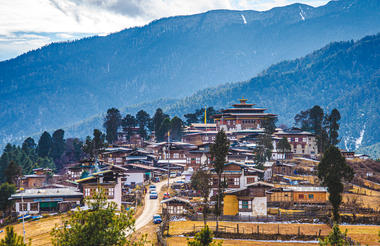
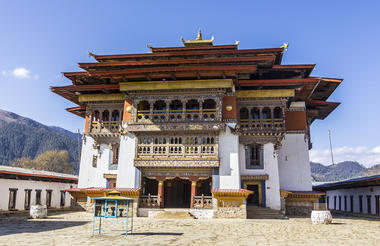
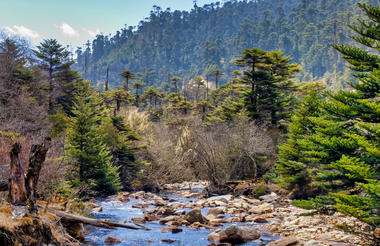
This morning after breakfast you will walk along the Gangtey Nature Trail, a popular excursion for those who enjoy hiking. Leaving the Goemba and crossing streams, past the Sumchubara village, you enter mixed forests, much of it covered in Spanish moss. Emerging from the trees, the path opens up to a fabulous view of the valley and the marshy conservation area below. The trail will end in the village of Khewang as you cross the Nake Chu. Altitude descent: 224 m (734 ft). Distance: 4.6 km (2.9 mi). Hiking time: 2 hours.
On the way back, visit Black-necked Crane Education Centre. A visit to this Centre is a great way to learn about the endangered black-necked crane and the folklore that surrounds them. These splendid birds occupy a very special place in Bhutanese culture. The centre is equipped with spotting scopes, installed to improve your experience and watch the cranes as they fly around. They are only seen from the months of November to February, but there is an enclosure where rescued cranes are rehabilitated. Amongst the educational exhibits, you can also enjoy a 15-minute documentary called “The Birds of Heaven”.
Rest of the day at leisure.

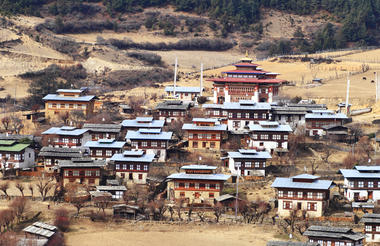
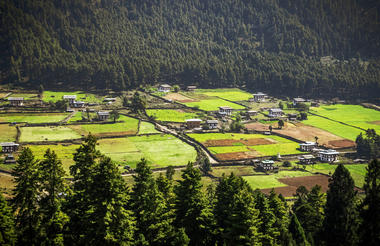
This morning post breakfast, be chauffeured to Bumthang (5 hour’s drive).
Bumthang Dzongkhag (district) spans from 2600 - 4500 m (8530 - 14763 ft) encompassing four major valleys. The Ura, Chumey, Tang and Choekhor valleys are broad and gentle, largely scenic and quite the sight for travellers to visit. Bumthang is the religious heartland of Bhutan and home to many of the oldest and most sacred monasteries. In addition to being rich in historical and spiritual legacy, it is also an important agricultural area. The valleys are full of buckwheat, rice, potato, apple and dairy farms. With an air of peace and serenity, Bumthang has plenty of opportunities for day hikes, many involving visits to remote ancient monasteries, such as Jambay Lhakhang, which was built in 659 CE. This district has the only airport in central Bhutan.
Check in at the lodge. Enjoy the rest of the day at the property.
Spend three nights at Six Senses, Bumthang. Your accommodation will be in Lodge Suite on Full board (Breakfast, lunch, dinner, and non-alcoholic beverages) basis.
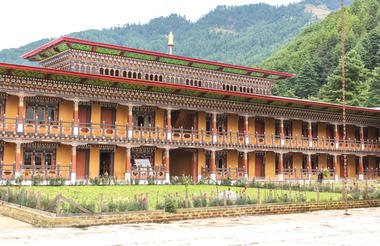
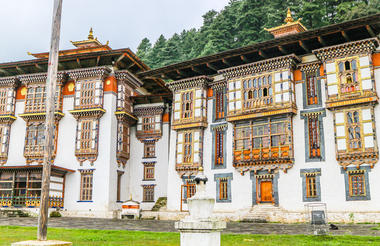
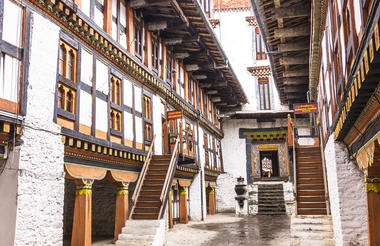
After breakfast, walk (approx. 30 minutes’ walk) to Jambay Lhakhang. An intriguing tale surrounds the beauty of Jambay Lhakhang. In the 7th century, when it was built, there was said to be a giant demoness who was preventing the spread of Buddhism in Tibet and the Himalayan region. To overcome her, the Tibetan king Songtsen Gampo decided to build 108 temples in one day, in an attempt to pin down her entire body. Jambay Lhakhang holds down the left knee and Kyichu Lhakhang in Paro pins down the left foot. Famous for Ter Cham, a cultural dance
After breakfast, walk (approx. 30 minutes’ walk) to Jambay Lhakhang. An intriguing tale surrounds the beauty of Jambay Lhakhang. In the 7th century, when it was built, there was said to be a giant demoness who was preventing the spread of Buddhism in Tibet and the Himalayan region. To overcome her, the Tibetan king Songtsen Gampo decided to build 108 temples in one day, in an attempt to pin down her entire body. Jambay Lhakhang holds down the left knee and Kyichu Lhakhang in Paro pins down the left foot. Famous for Ter Cham, a cultural dance
which takes place every year in October. This temple was originally built in 659 CE.
Here you will attend Jambay Lhakhang Drup (festival). The Jambay Lhakhang Drup is a festival held to commemorate the establishment of the Jambay Lhakhang. Other than the traditional masked dances performed, the chams (dances) include the Ter Cham (naked dance), and Me-wang (fire blessing ceremony) performed by local villagers. Crowds of people gather in their finest hand-woven Gho's and Kira's. This brightly patterned clothing adds to the colourful and exciting atmosphere of the festival. Locals believe that by dressing in their finest, it's a form of offering that could bring them blessings and give them an opportunity to please the deities. This in return will bring them merit, luck and prosperity. The festival is also an occasion to meet with their friends and family to celebrate.
Afterwards walk further to visit Kurje Lhakhang (approx. 20 minutes).
Named after the body (kur) print (je) of Guru Rinpoche, this temple is where the first seeds of Vajrayana Buddhism were sowed in Bhutan in the 8th century. It comprises three separate temples, Guru Lhakhang, Sangay Lhakhang and Sampa Lhundrup Lhakhang, which were all built at separate times, the earliest being in 1652. Within Sangay Lhakhang, which one enters gets to by crawling through a small rock passage (The Bhutanese believe the act of crawling through a narrow tunnel you is believed to leave your sins behind by the Bhutanese) lies the meditation cave, where Guru Rinpoche left his body imprint. The Sampa Lhundrup Lhakhang was built in 1900 by Ugyen Wangchuk, the first king of Bhutan, when he was still penlop of Trongsa.
Drive back to your hotel for lunch and a short rest.
Post lunch, visit the Jakar Dzong. Built in 1549, the 'Castle of the White Bird' is a central attraction in Chamkhar valley, overlooking the town of Jakar. This dzong was built by the Tibetan Lam Nagi Wangchuk and played a crucial role as the fortress of defence for all the eastern Dzongkhags. Legend has it that a white bird signalled to the people exactly where to build this towering structure, hence the name, Jakar, which translates into white bird in Bhutanese. Jakar Dzong was the seat of the first king of Bhutan. Unlike other dzongs, the tower is attached to an outer wall, and not located in the centre of the building. The dzong is located on a picturesque ridge with a commanding view of the Choekhor valley. The current structure was built in 1667 (refurbished in 1683).
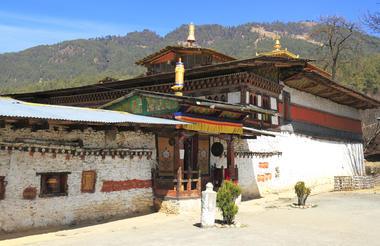
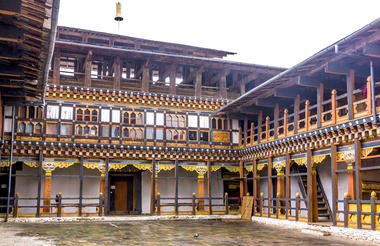
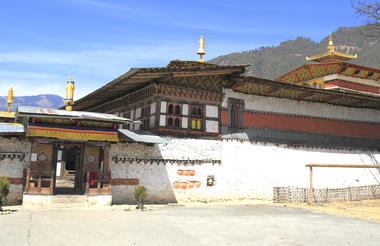
After an early breakfast, drive towards Tang Valley with a packed lunch (needs to be pre-ordered). On your way there, stop to visit Mebar Tsho (The Burning Lake).
A five-minute walk from the road leads to a glittering pool in the Tang River called Mebar Tsho, which translates into burning lake. In this lake, Terton Pema Lingpa, the reincarnation of Padmasambhava, was said to have discovered religious treasure in the 12th century. Mebar Tsho is less a lake and more a gorge in one of the many glistening rivers that run through Tang valley. This sacred lake is visited by many Bhutanese during auspicious days to offer butter lamps. With an extensive array of prayer flags blowing in the wind, it is known to be one of the holiest places for Buddhist pilgrimage.
Being one of the remotest of Bumthang's valleys, Tang valley is a 10.5 km (6.5 mi) drive on an unpaved road from the main highway. The people of this valley raise sheep and at higher elevations, yak. It is also a major producer of buckwheat, and during late August and September the lower hillsides, and valley floor are a blush of pink flowers. In addition to its beautiful landscapes the valley also affords the opportunity to visit 16th century Naktshang (country manor)/Tang Ugyencholling Palace, which was built in the 16th century, and later renovated. Today the palace functions as a museum to preserve its legacy and provide a place for religious studies, research and solitude. The fascination and well-captioned exhibits offer real insights into the lifestyle of a Bhutanese noble family. The highlights include a book of divination, a dakini dance costume made of bone and the revelation that petrified yak dung was one of the ingredients for Bhutanese gunpowder. The museum is a 45-minute walk uphill to the hilltop.
You can either have your packed lunch at the manor’s courtyard or by the riverside in the valley.
Rest of the day at leisure.



This morning post breakfast, you will take a Domestic flight to Paro.
Paro is a historic town, situated at 2250 m (7382 ft,) with many sacred sites and historical buildings scattered through the area. It is home to many of Bhutan's oldest temples and monasteries, the National Museum and the country's only airport. Mt Jhomolhari (7326 m /24035 ft) reigns in its white glory at the northern end of the valley. Its roaring glacial water plunges through deep gorges to form the Pa Chu (Paro River). Paro is one of the most fertile valleys in the Kingdom, producing a bulk of the locally famous red rice from its terraced fields.
On entering Paro town, drive directly to your hotel for Check-in and lunch.
Post lunch visit the Ta Dzong; a watch tower built to defend Rinpung Dzong during the inter-valley wars of the 17th century. Since 1967, the Ta Dzong has been serving as the National Museum of the country. It holds a fascinating collection of art, relics, religious thangka paintings, natural history, and Bhutan's exquisite postage stamps. The building's circular shape comes from its defensive origin.
Afterwards, visit a Farmhouse. The beauty of Paro valley is embellished by clusters of old-fashioned farmhouses. Bhutanese farmhouses are very colourful, decorative and traditionally built without the use of a single nail. All houses follow the same architectural pattern. A visit to a traditional farmhouse is educational and offers a glimpse into the lifestyle of a farmer.
Spend two nights at Amankora, Paro. Your accommodation will be in Luxury Suite on Full board (Breakfast, lunch, dinner, and in-house beverages) basis.



Early this morning, take a short drive to Ramthankha, and start your hike to the Taktsang monastery (Tiger’s Nest). Built on a sheer cliff face at a height of 2950 m (9678 ft.), the four-hour trek offers spectacular views. The trail climbs through a beautiful pine forest, many of the trees festooned with Spanish moss and an occasional grove of fluttering prayer flags. Legend has it that Guru Rinpoche, founder of Buddhism in Bhutan flew from eastern Bhutan on a tigress, bringing Buddhist teachings and meditation here on this cliff. This is one of the most venerated and sacred of all Buddhist sights around the world. This hike takes about five hours with a 900 m (2952 ft) approximate gain in altitude.
In the evening visit to Phurba Mandala Display Center. A Mandala represents a sacred geometric figure, typically in a circular form. Mandalas are sacred creations in Buddhist traditions, rich in symbolism and meticulously crafted. It symbolizes a holy location utilized for reflection, meditation, wholeness, and unity. Witness skilled artisans creating intricate sand mandalas and learn about their cultural significance.



This morning you will be chauffeured to Paro airport to board your onward flight.




